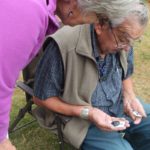 Through the Visitor Center in Queen Charlotte City, we were put in touch with Dick Bellis (Skil Q’uas), a 77 year old native born here of a Finnish man and a Haida woman. Dick has had many jobs and experiences over all these years and now spends some time guiding tourists. We hired Dick to show us some of the northern island, Graham Island, as our own adventuring will soon take us south. This man knows half the people we see and has stories about almost everything.
Through the Visitor Center in Queen Charlotte City, we were put in touch with Dick Bellis (Skil Q’uas), a 77 year old native born here of a Finnish man and a Haida woman. Dick has had many jobs and experiences over all these years and now spends some time guiding tourists. We hired Dick to show us some of the northern island, Graham Island, as our own adventuring will soon take us south. This man knows half the people we see and has stories about almost everything.
 With Dick driving and talking, we learned about the forests (Dick was a logger for many years) and how the Haida made and make huge logs into canoes and how Howard Hughes’ Spruce Goose was made of Haida Sitka spruce, the “best in the world”. We met woodworkers and argillite carvers in their homes and workshops. We also watched young men carving the largest yellow cedar tree we have ever seen into a totem pole that will be erected soon at the University of British Columbia.
With Dick driving and talking, we learned about the forests (Dick was a logger for many years) and how the Haida made and make huge logs into canoes and how Howard Hughes’ Spruce Goose was made of Haida Sitka spruce, the “best in the world”. We met woodworkers and argillite carvers in their homes and workshops. We also watched young men carving the largest yellow cedar tree we have ever seen into a totem pole that will be erected soon at the University of British Columbia.
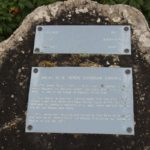 Dick (and his now diseased younger brother) are carvers as well. Dick told us that he has the Guinness Book of World Records for his carving of a very tall great blue heron – chain-saw carving.
Dick (and his now diseased younger brother) are carvers as well. Dick told us that he has the Guinness Book of World Records for his carving of a very tall great blue heron – chain-saw carving.
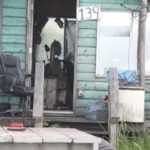 Dick took us to what he thought were the best shops for Haida art and he does have good taste. One overly-complex construction we saw was priced at $175,000. It looked like it had been there on display for quite a while. Myles Edgars was working the soft black shale intently, making a very dusty mess in a very basic house when we found him. He opened a drawer in his worktable and pulled out an argillite totem pole that he was going to sell for $10,000 to whomever walked in and wanted it. Beautiful as this was, we were not that party.
Dick took us to what he thought were the best shops for Haida art and he does have good taste. One overly-complex construction we saw was priced at $175,000. It looked like it had been there on display for quite a while. Myles Edgars was working the soft black shale intently, making a very dusty mess in a very basic house when we found him. He opened a drawer in his worktable and pulled out an argillite totem pole that he was going to sell for $10,000 to whomever walked in and wanted it. Beautiful as this was, we were not that party.
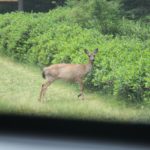
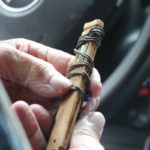 Dick stopped and had us gather what he called “Labrador Tea”. We will dry it as instructed and see if it provides a healthful and tasty hot beverage. At one point, we saw yet another deer on the road and Dick slowed to a stop and reached into his center console and picked up a deer whistle that he had made. He said that the sound was that of a fawn. One or two little toots, and that deer came closer and closer, seemingly trying to find that fawn.
Dick stopped and had us gather what he called “Labrador Tea”. We will dry it as instructed and see if it provides a healthful and tasty hot beverage. At one point, we saw yet another deer on the road and Dick slowed to a stop and reached into his center console and picked up a deer whistle that he had made. He said that the sound was that of a fawn. One or two little toots, and that deer came closer and closer, seemingly trying to find that fawn.
Deer are a purposely introduced species here, Dick told us, along with beaver and raccoons. Rats are introduced as well and not on purpose and not welcome – especially for ground-nesting birds such as tufted puffins. The Haida are experimenting with deer exclosures to allow native species such as red cedar to regenerate and have been working to remove rats from some of the small islands. When we saw a fawn, a young Heida woman told us with a wink that all she needed was “an apple and a hammer”. She said she loves deer (meat).
We went to artist April White’s home in Old Masset to see if we could say “hi”. We knew that she was around, as various shop owners had recently seen her but it seems she was off fishing. We got to know April from the many visits that we had with her while she and Farhad were together.
Val had taken to asking various guides and people whether the Haida had any ancient knowledge of the Stellar Sea Cow, a 30 foot long cold water manatee. It was discovered in the early 18th century by George Steller (on the Bering Expedition) and was soon extirpated by Russian hunters as food while seeking sea otter fur. The young spokesperson for the Haida Museum had no knowledge of this animal, and neither did Dick. Dick was interested, however, and sought out various Haida elders to ask them. So far no information seems to have been transported by this culture’s oral tradition about an animal that most certainly was in these waters up until 250 years ago. We keep wondering if one of the figures on some old, old totem pole might be a Stellar Sea Cow.

 Dick’s friend, who we saw as he was mowing the grass at the Masset cemetery, came over to his car and said, “Dick has lots of stories; some of them are true.” There we saw where skeletons collected by the Field Museum in Chicago and been repatriated.
Dick’s friend, who we saw as he was mowing the grass at the Masset cemetery, came over to his car and said, “Dick has lots of stories; some of them are true.” There we saw where skeletons collected by the Field Museum in Chicago and been repatriated.
Here are some Dick Bellis quotes:
“Very, very very” – used very, very, very often in all manner of positive situations
“If you watch too much TV, you get square eyes”
“You lose your language, you lose your culture” – all the kids learn Haida in school
“We are a people of the water” – Dick was a logger and diesel mechanic and scuba diver
“Whenever a single orca comes into the bay at Masset, it means than an elder will die”
“One more five minute stop, if you like” – referring to Leslie going to yet another lovely gallery
We learned so much from this very positive older fellow who certainly loves to help people and loves his home and culture. Now, we sail south to uncharted waters (for us) in Gwaii Haanas, the “Place of Beauty”.
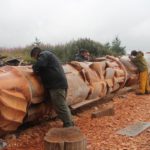
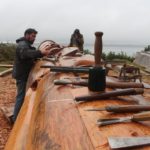


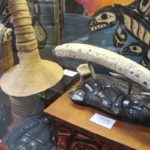

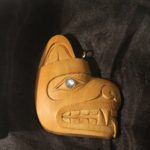

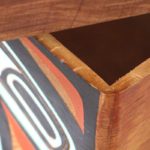


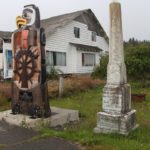




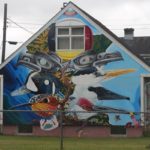







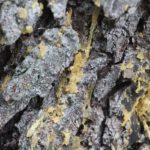
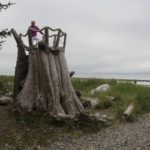

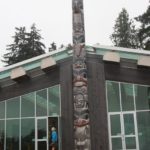
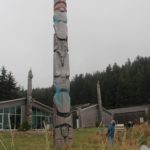
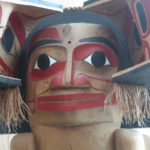

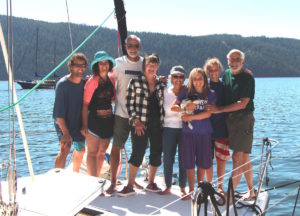

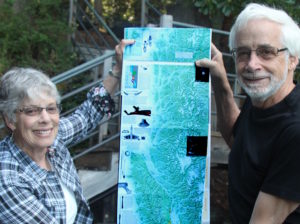
Julia
3 Aug 2016Thank you for the glimpse of so much lovely art work! Lucky you to see all this even if priced too high to buy,
Julia